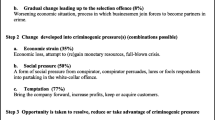Abstract
This article examines how changes in penal ideology may affect the experiences of white-collar offenders under community supervision. In-depth interviews with white-collar offenders on their experiences while under federal probation are used to examine how changes in criminal punishment have undermined the traditional reintegrative and rehabilitative goals of community supervision. The analysis suggests that shifts to a more managerial, actuarial model that seeks depersonalized efficiency has unintended consequences that delegitimatize the criminal justice system, and foster sentiments of degradation. Based on these findings, considerations for future research are discussed.
Similar content being viewed by others
References
Baynes, G. J., Manske, M. W., & Smykla, J. O. (1998). The impact of the “new penology” on ISP. Criminal Justice Review, 23, 51–62.
Benson, M. L. (1982). Collateral consequences of conviction for a white-collar crime. Unpublished dissertation, Ann Arbor, MI: University Microfilms International.
Benson, M. L. (1984). The fall from grace: loss of occupational status as a consequence of conviction for a white-collar crime. Criminology, 22, 573–593.
Benson, M. L. (1985). White-collar offenders under community supervision. Justice Quarterly, 2, 429–438.
Benson, M. L. (1990). Emotions and adjudication: status degradation among white-collar criminals. Justice Quarterly, 7, 515–528.
Benson, M. L., & Cullen, F. T. (1988). The special sensitivity of white-collar offenders to prison: a critique and research agenda. Journal of Criminal Justice, 16, 207–215.
Benson, M. L., & Walker, E. (1988). Sentencing the white-collar offender. American Sociological Review, 53, 294–302.
Blumstein, A. (1994). Prisons. In J. Q. Wilson & J. Petersilia (Eds.), Crime (pp. 387–419). San Francisco: ICS Press.
Christie, N. (1993). Crime control as industry. London: Routledge.
Clear, T. R. (1994). Harm in American penology: Offenders, victims and their communities. Albany, NY: SUNY Press.
Clear, T. R., & Dammer, H. R. (2000). The offender in the community. Belmont, CA: Wadsworth.
Clinard, M., & Yeager, P. (1980). Corporate crime. New York: Free Press.
Crank, J. P. (1996). The construction of meaning during training for probation and parole. Justice Quarterly, 13, 1996.
Crouch, B. M. (1993). Is incarceration really worse? Analysis of offenders’ preferences for prison over probation. Justice Quarterly, 10, 67–88.
Cullen, F. T. (1995). Assessing the penal harm movement. Journal of Research in Crime and Delinquency, 32, 338–358.
DiIulio, J., Jr. (1991). Understanding prisons: the new old penology. Law & Social Inquiry, 16, 65–114.
Eitle, D. J. (2000). Regulatory justice: a re-examination of the influence of class position on the punishment of white-collar crime. Justice Quarterly, 17, 809–839.
Feeley, M. M., & Simon, J. (1992). The new penology: notes on the emerging strategy of corrections and its implications. Criminology, 30, 449–474.
Fishman, L. T. (1990). Women at the wall: A study of prisoners’ wives doing time on the outside. Albany, NY: SUNY Press.
Garfinkle, H. (1956). Conditions of successful degradation ceremonies. American Journal of Sociology, 61, 420–424.
Garland, D. (1990). Punishment and modern society. Chicago: University of Chicago Press.
Glasser, B. G., & Strauss, A. (1971). Status passage. Chicago: Aldine.
Gordon, M. A., & Glaser, D. (1991). The use and effects of financial penalties in municipal courts. Criminology, 29, 651–676.
Hagan, J., & Palloni, A. (1986). “Club Fed” and the sentencing of white-collar offenders before and after Watergate. Criminology, 24, 603–621.
Hagan, J., & Parker, P. (1985). White-Collar crime and punishment: the class structure and legal sanctioning of securities violations. American Sociological Review, 50, 302–316.
Irwin, J. (1979). The felon. Berkeley: University of California Press.
Kerley, K., & Copes, H. (2004). The effects of criminal justice contact on employment stability for white-collar and street-level offenders. International Journal of Offender Therapy and Comparative Criminology, 48, 65–84.
Mann, K., Wheeler, S., & Sarat, A. (1980). Sentencing the white-collar offender. American Criminal Law Review, 14, 479–500.
Martinson, R. (1976). California Research at the Crossroads. Crime and Delinquency, 22, 178–191.
Mason, K. A. (2000). They do time too: the effects of imprisonment of the families of white-collar offenders. In G. L. Fox & M. L. Benson (Eds.), Families, crime and criminal justice (pp. 325–337). New York: Elsevier Science, INC.
McCorkle, R., & Crank, J. P. (1996). Meet the new boss: institutional change and loose coupling in parole and probation. American Journal of Criminal Justice, 21, 1–25.
Payne, B. K. (2003). Incarcerating white-collar offenders. Springfield, IL: Charles C. Thomas.
Petersilia, J. (1990). When probation becomes more dreaded than prison. Federal Probation, 54, 23–27.
Shapiro, S. P. (1985). The road not taken: the elusive path to criminal prosecution for white-collar offenders. Law & Society Review, 19, 179–217.
Shapiro, S. P. (1990). Collaring the crime, not the criminal. American Sociological Review, 55, 346–365.
Shover, N., Coffey, G. S., & Sanders, C. R. (2004). Dialing for dollars: opportunities, justifications, and telemarketing fraud. Qualitative Sociology, 27, 59–75.
Stanley, D. T. (1976). Prisoners among us: the problem of parole. Washington, DC: Brookings Institute.
Tillman, R., & Pontell, H. R. (1992). Is justice “collar-blind”?: punishing Medicaid provider fraud. Criminology, 30, 547–573.
Weisburd, D., Waring, E., & Chayet, E. F. (2001). White-collar crime and criminal careers. New York: Cambridge University Press.
Weisburd, D., Wheeler, S., Waring, E., & Bode, N. (1991). Crimes of the middle-classes: white-collar offenders in the federal courts. New Haven, CT: Yale University Press.
Wheeler, S., Mann, K., & Sarat, A. (1988). Sitting in judgment: the sentencing of white-collar offenders. New Haven, CT: Yale University Press.
Wheeler, S., Weisburd, D., & Bode, N. (1982). Sentencing the white-collar offender: rhetoric and reality. American Sociological Review, 47, 641–659.
Whitehead, J. T., & Braswell, M. C. (2000). The future of probation: reintroducing the spiritual dimension into correctional practice. Criminal Justice Review, 25, 207–233.
Willot, S., Griffin, C., & Torrance, M. (2001). Snakes and ladders: upper-middle class male offenders talk about economic crime. Criminology, 39, 441–466.
Wilson, J. Q. (1975). Thinking about crime. New York: Random House.
Author information
Authors and Affiliations
Corresponding author
Rights and permissions
About this article
Cite this article
Mason, K.A. Punishment and Paperwork: White-Collar Offenders Under Community Supervision. Am J Crim Just 31, 23–36 (2007). https://doi.org/10.1007/s12103-007-9001-3
Received:
Accepted:
Published:
Issue Date:
DOI: https://doi.org/10.1007/s12103-007-9001-3



